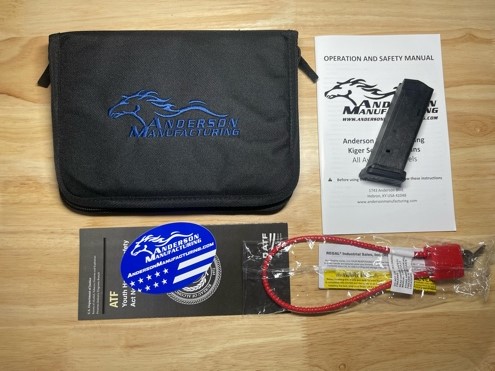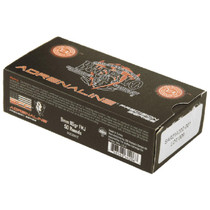First Look: Anderson Kiger-9C
Posted by Cory Ross on Oct 25th 2022

In the firearms space there are moments of genius that have transcended time. Examples include Benjamin Tyler Henry’s 1860 repeating rifle, Samuel Colt’s 1873 Single Action Army, John Moses Browning’s 1911, Hiram Maxim’s Machine Gun, and more recently, Gaston Glock’s polymer framed 9mm model 17. While most of these guns were built over a century ago, the implications they have on today’s world are unceasing. The same can be said of Glock’s polymer framed guns. Gaston set to designing his famed pistol in the early 1980s. It was first marketed to the Austrian military and law enforcement, but the gun drew an international audience. By November of 1986, Glock opened its American headquarters in Smyrna, Georgia. Today, roughly 65% of all federal, state, and local law enforcement agencies in the U.S. use Glock pistols in a plethora of sizes and calibers. Glocks today are the status quo for all other polymer guns to be compared to. Glock is a titan in the gun world, but success breeds competition.
For decades, Glock held tight to their patent and trademark rights on their pistols. Anything that came close to mimicking was fought with legal action. However, these protections have expiration dates. Recently, the patents on many Generation 3 Glocks expired. It can be argued that the Gen 3 iteration was Glock’s most successful model; selling millions worldwide. Competitors lined up with engineers in hand to “copy” or “clone” the successful Glock model. The model 19 was first for many companies to bring facsimiles of to market. Fast forward to today, dozens of “look-a-like” Glocks are on the market. Each one takes the base Gaston design and enhances it to their specs to create a better shooting experience for the end user.
That is where we enter the present day, October 25, 2022. Anderson Manufacturing, known for making affordable AR stripped lower receivers and dozens of other AR-15 parts, has entered the foray into Glock clones. The Kiger-9C takes the standard Glock 19 footprint and enhances the design to the needs of the modern shooter while making it affordable. The name of the gun, at first, seems a bit odd. Anderson’s longtime logo is a horse, or mustang, galloping into the distance. Mustangs represent a form of freedom and mystique, tantalizing those trying to tame them. A Kiger is a mustang found today in Oregon, a horse thats lineage dates back to Spanish steeds that were brought to the western lands of the new world.
|
|
|
Anderson markets the Kiger as “an independent, bold, and powerful striker-fired, polymer handgun. Its sleek lines, and short, crisp trigger pull, allow the user to be confident, quick, and accurate, even under extreme conditions. The 15+1 capacity give you the freedom to discreetly carry wherever and whenever you need to. Compatible with most Glock Gen 3 aftermarket accessories, you’ll never run out of ways to customize your Kiger to fit your unique personality.” These are big claims by a manufacturer. When going over the gun, some features I like initially are the grip ergonomics—the double under cut along the trigger guard gives you a much higher grip—the texturing along the grip itself, and the slide serrations that make for easy slide manipulation. Other beneficial features include a slide made out of billet stainless steel, Diamond Like Coating (DLC) on the slide and barrel, bevelled magazine well with debris channels, and a normal pic rail underneath for mounting accessories (no more Glock propriety rail). Oh and the price, $429.99 MSRP with street prices around $399.99.
As for negatives, there isn’t anything I truly don’t like, however, there are things that I wish were added for the initial offering. I wish the Kiger came with an optics cut as a standard feature. In 2022, that has become the standard, especially on Glock style polymer pistols. I’d imagine that a future model will have it, at an increased price, of course. The gun seems to use an OEM Glock trigger, that isn’t necessarily a bad thing, but with a host of options out there, it’s something else that could have been addressed. As for accoutrements that ship with the pistol, the user will receive a single Magpul Glock magazine, a lock, sticker, a small pistol bag, and an owner’s manual. Of course, once the Kiger is made available, there will be a plethora of reviews talking positively or negatively about the firearm, so it will be up to the viewer to discern if there are any true negatives (i.e. failure to feeds, malfunctions, grip hot spots, etc.).
|
|
|
One point of note. I have three different Glock 19 holsters. A Tier 1 Concealed and a T-Rex Ragnarok that are light bearing with a SureFire X300U along with a BladeTech. The Kiger didn’t fit in any of them. A further note, I use these holsters with a Shadow Systems MR920–another Glock 19 clone—without issue. It may be because of the pic rail instead of the Glock rail, but I’m not sure. My guess is they will work with Polymer 80 specific holsters (another Glock clone company). The Kiger frame seems similar to their frames.
It is exciting to see companies challenge the standard and produce quality guns at affordable prices. The Kiger is a relatively stripped down design that does enhance some of the deficiencies of the 19 Gen 3. At $399.99 it brings a solid defensive handgun to market without the need to spend substantially (think, the money saved could be used on ammo and training). The gun will be released by the time this article is posted. Shop Anderson Kiger

|

|

|


















